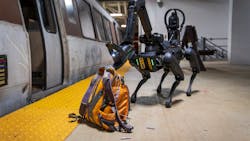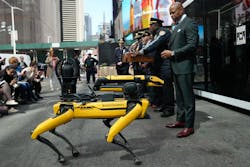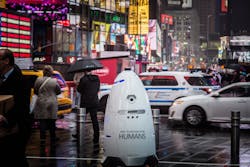The Future of Law Enforcement: How Police are Embracing Robots
On paper, the April press conference by New York City Mayor Eric Adams and NYPD Commissioner Keechant Sewell was to announce a new technological push by the department and unveil some of the newest tools in that effort. But the Times Square event seemed more like a Big Apple debut for two Broadway stars.
This article appeared in the March/April issue of OFFICER Magazine. Click Here to subscribe to OFFICER Magazine.
Spot—Boston Dynamics’ yellow quadruped robot that some have dubbed a “digidog”—strutted in front of photographers, descending steps from a portable glass-enclosed stage and even performing a “sit” command in movements that echoed a flesh-and-blood canine. In one instance, a “playful” Spot deftly removed the wind sock from a reporter’s microphone with a mandible on its extension arm.During its turn in the spotlight, Knightscope’s K5 Autonomous Security Robot (ASR) glided its rounded, 400-pound frame—think of a curvier Dalek from the British “Dr. Who” TV series—along the stage on ramp-accessible wheels. The department plans to keep K5 in the city’s Broadway Theater District, with robots either patrolling the streets or the subway stations in the area.
“We are scanning the globe on finding technology that will ensure this city is safe for New Yorkers, visitors and whomever is here in the city,” Adams said at the press conference. “This is the beginning of a series of rollouts.”
The introduction might’ve seemed like a scene from a science-fiction movie, and it wouldn’t have been surprising if some expected to see Robocop emerge on stage. Fiction aside, law enforcement and robots have had a long relationship. Large, tank-like robots have been used by police departments and other agencies for years for bomb disposal.But a new generation of robots designed to be deployed in a variety of functions is joining drones as high-tech tools to not only protect the public but also officers’ lives. Advances in artificial intelligence and the embrace by agencies like the NYPD—the largest police department in the country—are pushing law enforcement future into the present.
“Robots have been operating in public safety applications for decades, but legged mobile robots like Spot can go places that are inaccessible to previous generations that use wheels or tracks,” Nikolas Noel, the director of marketing communications, told OFFICER Magazine.
Spot’s ability to traverse stairs, curbs and loose gravel with its four legs gives it versatility when it comes to the jobs where it can be deployed. It can be used to investigate unexploded ordnance or suspicious packages, help in search-and-rescue operations and provide assessments of high-risk incidents, such as standoffs and hostage situations.
To accomplish these missions, Spot is equipped with 360-degree vision to allow it to map terrain and avoid obstacles. It can carry roughly 30 pounds and has a mounting rail and paylord ports to additional equipment. Police officers and other first responders can operate it with a tablet app and use built-in stereo cameras to guide it.
Before its April unveiling with the NYPD, Spot had seen action with other departments around the country. Last year, Houston police used the automaton to help apprehend a capital murder suspect barricaded in a home. Also in 2022, a St. Petersburg, Florida, SWAT unit deployed Spot to help rescue a 3-year-old boy who was held hostage in an armed standoff. In April, the robot dog used by the Massachusetts State Police could be seen patrolling the route of the Boston Marathon.
And Spot even saw some action in New York City albeit not the NYPD unit. A day after the Times Square press conference, the digidog belonging to the FDNY was used to search for people possibly trapped in the rubble of a collapsed parking structure in Manhattan.
“Spot helps keep people out of harm’s way and aids first responders in assessing dangerous situations,” Noel said.
Meet K5
When Stacy Stephens, a co-founder of Knightscope, describes what it was like to watch K5 appear on arguably the largest media stage with its New York City coming-out party, he immediately sums it up with a single word: surreal.
“You’re talking about an agency that the entire country watches on a regular basis,” says Stephens, a former police officer. “To be able to sit there with the mayor, commissioner and chief of the department and to have them stand in front of our robots and go, ‘You know what? This is the technology we have to be able to adopt.’ I couldn’t agree more. Criminals are unconstrained in what they have the ability to use, and law enforcement deserves nothing but the best to combat that.”
K5 is designed to autonomously patrol indoor and outdoor areas much like an officer would walk a beat, keeping an eye out for anything place and potentially gathering evidence. It’s outfitted with 360-degree, eye-level HD video streaming and recording functions, as well as license plate recognition capabilities. Sensors can detect thermal anomalies, abnormal noise and even suspicious wireless signals and alert command. K5 can reach speeds of up to 3 mph, and its ultrasonic sensor helps it navigate around objects.
The robot’s construction also provides a secondary, almost psychological benefit, says Stephens. With its bullet contours, K5 is built to be approachable by the public, allowing civilians to think they’re interacting with a solid-body R2-D2.
“It brings a little bit more curiosity, and people engage with them in a much better way,” says Stephens, adding that K5 is designed for officers and the public to feel safe around.
“That absolutely played into the design process,” he says. “Not only what the robot does in its features and capabilities but the aesthetics. What it looks like, how it moves, the speed at which it travels. All of those things were affected by making sure we keep an eye on the community policing aspect of it, so people feel like we’re doing our jobs in law enforcement effectively.”
Like Spot, K5 had been in use in other places before its adoption by the NYPD. The Huntington Park Police Department in California employs a unit—named HP Robocop—and a robot can be seen patrolling the Orange County Convention Center in Orlando as an automated security guard.
Stephens says the primary role of law enforcement robots is doing the things officers can’t. That can mean performing tasks and gathering information in places officers can’t reach or in situations too risky for officers. But he doesn’t overlook the other benefits robots can have on departments and the public they serve.
“It’s a technology tool to help actually do a good job,” he says. “It’s an engagement tool for opening up conversations and letting people talk, and it’s a recruitment tool. … If you have the opportunity to go work with a department that has shoddy equipment, they’re not caught up, they’re not using the most modern things, and you go to a department that has robots and has all the latest and greatest tools, do you think that’s going to weigh on someone’s decision as to what job to accept? I do.”
Battling misconceptions
But what’s been driving the robot revolution in law enforcement? Ashley Johnson, senior policy analyst for the Information Technology and Innovation Foundation (ITIF), points to the leaps in technology and the speed at which they’ve been coming.
“I think a lot of it has to do with how AI technology has been getting a lot more sophisticated lately,” says Johnson, who moderated panel on law enforcement robots in January. “A lot of those same technologies are used to help advance robotics and make robots capable of doing things it wasn’t possible to do before, like navigate more effectively and in more sophisticated ways than robots have been able to, like climbing stairs, navigating around narrow spaces and obstacles.”
Cost also is a factor that is slowly making robots a more attractive option for departments. While robots can still be financially out of reach for many departments, Johnson points to how drones have become more affordable, making them nearly essential tools for law enforcement. Robots, she says, could follow the same path.
”Advanced robotics is early on in that cycle than drones are, but I think they’ll get more accessible and more affordable and more advanced as we’ve seen with drones.
Acceptance by police departments, however, does not necessarily mean acceptance by the public. Visions of ED-209—the out-of-control police robot from Robocop—fuel fears of police departments with robotic assistance, says Johnson. And that couldn’t be further from reality, she adds.
“I think a lot of lay people who aren’t super knowledgeable about robotics … it’s very easy for their first thought to be leaping to fictional portrayals of robots that are obviously unrealistic and not actually going on in the world, like Terminator and The Matrix.”
One of the ways to alleviate those misconceptions is to explain to people how the technology works, says Stephens. And part of doing that is reassuring citizens that the human factor isn’t lost in this new robotic age.
“There’s still always a human in the loop,” he says.“The decision-making process, still, even with our technology resides in the hands of the department, of the administrators and the like, so we don’t take that control out of there hands. I think that’s a very important thing for people to know and understand ahead of time.”
For law enforcement agencies, Stephens, Noel and Johnson all agree that the best thing they can do to assuage concerns about the use of robots is to be transparent when it comes to how they’re employed. To that end, Boston Dynamics has outlined ethical principles it follows, and the company has stated that any attempts to weaponize or arm their robots is strictly prohibited.
“Spot's role in public safety is to keep people out of harm's way, and most misconceptions stem either from a lack of understanding about how the robot works or concerns about how it might be used in a public safety context,” says Noel. “That's why it's so important for departments to establish clear use policies, and we always encourage our customers to publicly introduce and demonstrate the robot in the communities where it will potentially be operating. To that end, we were pleased to see the NYPD and FDNY's transparency in introducing Spot, and the use policy outlined by New York City officials reflects our commitment to the responsible use of our technology.”
This article appeared in the March/April issue of OFFICER Magazine.



